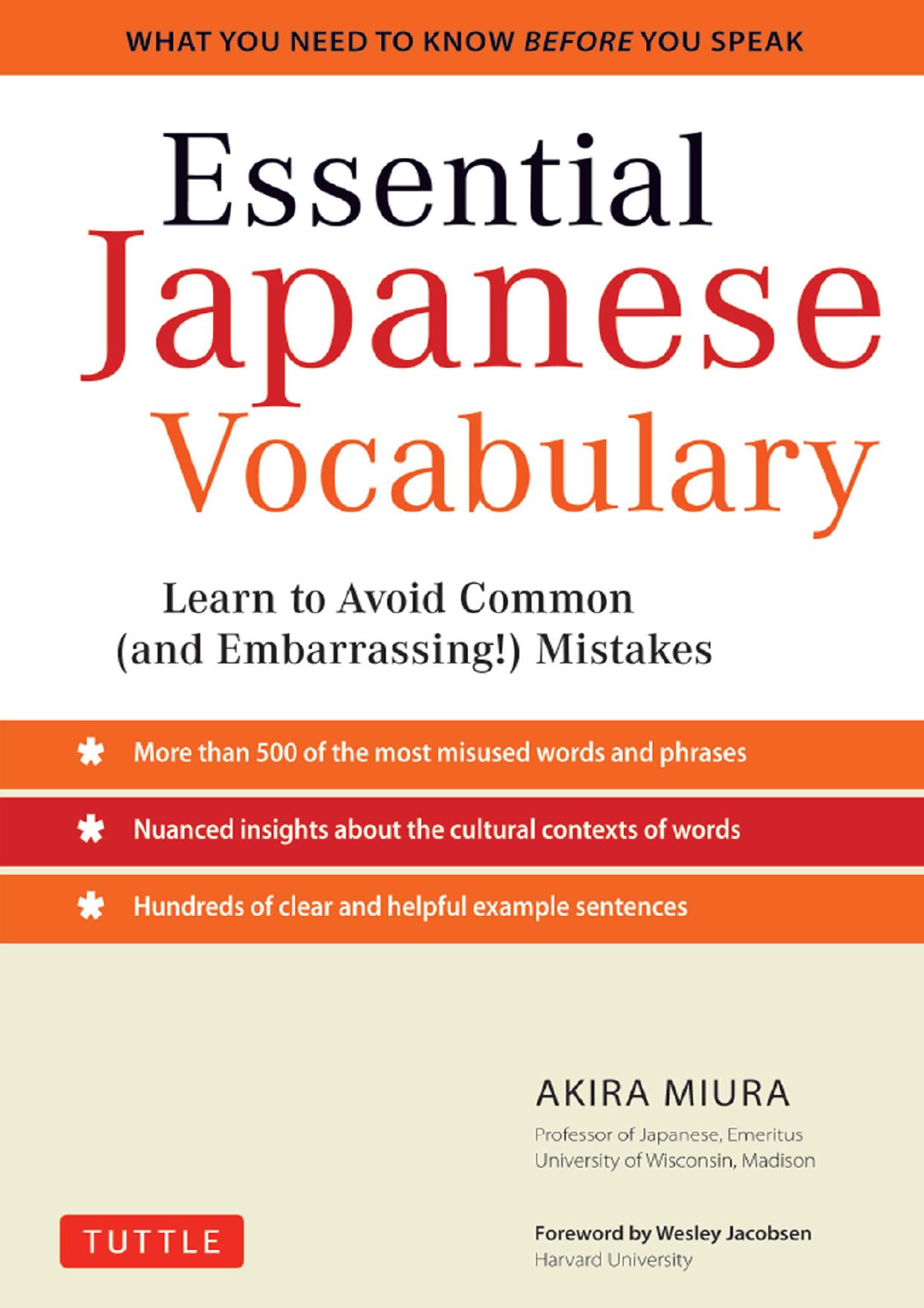Essential Japanese Vocabulary by Akira Miura

Author:Akira Miura
Language: eng
Format: epub, pdf
ISBN: 978-4-8053-1127-1
Publisher: Tuttle Publishing
In a narrow sense, however, namae 名前 means “given name” only.
EXAMPLE:
(2) Kare no myōji wa Tanaka de, namae wa Tarō da.
彼の名字は田中で、名前は太郎だ。
His family name is Tanaka, and his given name is Taro.
Nan da なんだ What!; Why!
Nan da なんだ ordinarily means “What is it?”, as in
EXAMPLE:
(1) Kore wa nan da.
これはなんだ。
What is this?
Nan da なんだ, however, is sometimes used not as an interrogative but rather as an exclamation of surprise, disappointment, or disgust. For example, suppose you hear some noise at the door and open it, expecting a visitor, but find only a stray cat. In that case, you are likely to say.
EXAMPLE:
(2) Nan da, noraneko ka.
なんだ、野良猫か。
Why, it’s a stray cat! (implication: To my disappointment, I find only a stray cat.)
Nan no hi 何の日 what kind of day
Nan no hi 何の日 literally looks like “what day,” but it does not really mean that. In English, if one asks “What day is today?”, it normally means “What day of the week is today?” In Japanese, on the other hand, if you want to know the day of the week, you must ask Kyō wa naniyōbi desu ka 今日は何曜日ですか, not Kyō wa nan no hi desu ka 今日は何の日ですか. Kyō wa nan no hi desu ka is used only when you are wondering whether today is any special day. Suppose you are walking along the street in Kyoto with a Japanese friend and suddenly see a long procession. You wonder what the procession is commemorating and ask your friend Kyō wa nan no hi desu ka, and your friend would say, for example, Kyō wa Gion Matsuri desu yo 今日は祇園祭ですよ (“Today is Gion Festival Day”).
Naosu 直す to correct, to repair, to cure
Naosu 直す basically means “to make [something] right” and is used to mean “to repair, to correct, to cure.”
EXAMPLES:
(1) terebi (tokei, kuruma, etc.) o naosu
テレビ(時計、車、 etc.)を直す
to repair a TV (watch, car, etc.)
(2) machigai (sakubun, bun, etc.) o naosu
間違い(作文、文、 etc.)を直す
to correct errors (compositions, sentences, etc.)
(3) byōki (byōnin, kaze, etc.) o naosu
病気(病人、風邪、 etc.)を治す
to cure an illness (sick person, cold, etc.)
Thus, naosu 治す has a much wider range of usage than either shūri-suru 修理する or shūzen-suru 修繕する, both of which can only mean “to repair.” Shūri-suru or shūzensuru can therefore replace naosu in (1) above, but not in (2) or (3). Shūri-suru and shūzen-suru are synonymous and can be used more or less interchangeably. Tokugawa and Miyajima (p. 194) suggest, however, that shūzen-suru might sound a little more dated than shūri-suru.
Narau 習う to study, to take lessons
Although narau 習う is often equated with “learn” by American students of Japanese, it is more like “study” in the sense that it does not imply mastery as does “learn.” (1) and (2) below are therefore correct, but (3) is not.
EXAMPLES:
(1) Uchi no musume wa ima piano o naratte-imasu.
うちの娘はいまピアノを習っています。
My daughter is taking piano lessons.
(2) Eigo wa roku-nen mo gakkō de naraimashita ga, jōzu ni narimasen deshita.
英語は六年も学校で習いましたが、上手になりませんでした。
I studied English for six years in school, but I never became good at it.
(3) *Aoki-san wa san-nen Amerika ni ita aida ni eigo o hitori de ni naraimashita.
Download
This site does not store any files on its server. We only index and link to content provided by other sites. Please contact the content providers to delete copyright contents if any and email us, we'll remove relevant links or contents immediately.
Cecilia; Or, Memoirs of an Heiress — Volume 1 by Fanny Burney(32435)
Cecilia; Or, Memoirs of an Heiress — Volume 2 by Fanny Burney(31871)
Cecilia; Or, Memoirs of an Heiress — Volume 3 by Fanny Burney(31856)
The Lost Art of Listening by Michael P. Nichols(7409)
Asking the Right Questions: A Guide to Critical Thinking by M. Neil Browne & Stuart M. Keeley(5644)
We Need to Talk by Celeste Headlee(5544)
On Writing A Memoir of the Craft by Stephen King(4863)
Dialogue by Robert McKee(4323)
Pre-Suasion: A Revolutionary Way to Influence and Persuade by Robert Cialdini(4150)
I Have Something to Say: Mastering the Art of Public Speaking in an Age of Disconnection by John Bowe(3842)
Elements of Style 2017 by Richard De A'Morelli(3307)
The Book of Human Emotions by Tiffany Watt Smith(3238)
Fluent Forever: How to Learn Any Language Fast and Never Forget It by Gabriel Wyner(3031)
Name Book, The: Over 10,000 Names--Their Meanings, Origins, and Spiritual Significance by Astoria Dorothy(2940)
Good Humor, Bad Taste: A Sociology of the Joke by Kuipers Giselinde(2904)
Why I Write by George Orwell(2875)
The Art Of Deception by Kevin Mitnick(2736)
The Grammaring Guide to English Grammar with Exercises by Péter Simon(2711)
Ancient Worlds by Michael Scott(2626)
